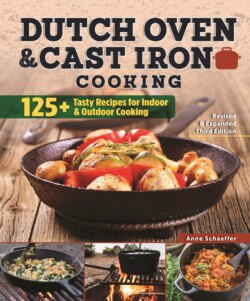Читать книгу Dutch Oven and Cast Iron Cooking, Revised & Expanded Third Edition - Группа авторов - Страница 8
На сайте Литреса книга снята с продажи.
Characteristics of Cast Iron Cookware
ОглавлениеIt’s versatile. Made from a single piece of metal, it can go directly from stovetop to oven and be used with campfires and grills. It will handle any style of cooking that you need—you can sauté, roast, bake and more. You can brown food in a skillet and then transfer it directly into a hot oven to finish cooking. That’s one-pot cooking at its best!
It’s heavy. This means your cast iron pots and pans will maintain an even cooking temperature once heated. This also means your cast iron cookware is durable, and it only gets better with age. A well-maintained cast iron piece can last for generations! Because it is heavy, look for sturdy handles on both sides to make handling easier, and use both hands to lift and move pans.
It can handle high temperatures. You’re going to get great results with cast iron cookware. Food will brown nicely and crusts will be crisp. The pots retain heat, so you can serve meals right out of your cookware without any concern that it will go cold. Do remember to use good pot holders and trivets, though!
It’s inexpensive, green cooking. It’s not very difficult to manufacture cast iron cookware, so compared to other top-of-the line pots and pans, it’s relatively inexpensive. If the price tag is still making you hesitate, keep in mind that if cared for, your cookware will last for years—and probably beyond—and won’t have to be replaced any time soon. If you don’t want to buy new, shop at second-hand stores or estate sales for used cookware.
It’s natural, nonstick cooking. Unlike other nonstick cookware, there are no artificial chemical coatings to be concerned about with cast iron. And if you keep your cast iron pots and pans well seasoned, you will have a natural, nonstick surface—all of the benefits of nonstick cooking without any synthetic materials, just the natural oils you use to season the cookware.
It can add an important nutrient to your food. When you cook with cast iron, a bit of iron leaches from the pan into the food being prepared, bumping up the iron content for your body to absorb. So just by cooking your food, you are making sure your body is well nourished—no extra vegetables or vitamins required! (Acidic foods, like tomato sauces, pull out more iron from the pans, so limit the cooking time of these foods to 30 minutes or less to avoid any metallic taste.)
How Did the Dutch Oven Get Its Name?
Dutch ovens and other cast iron cookware were distributed throughout America by salesmen with wagons. When a salesman or trader was seen coming with his pots clanging on the side hangers of his wagon, people would say, “Here comes the Dutchman with his ovens.”
Cast iron cookware will maintain an even cooking temperature once heated.
